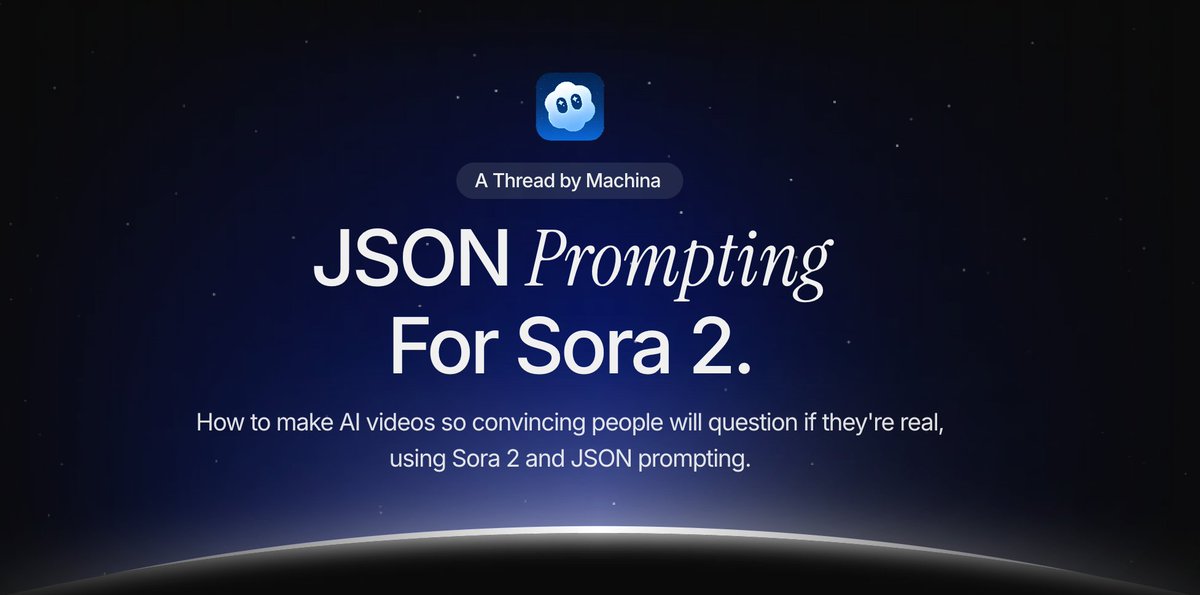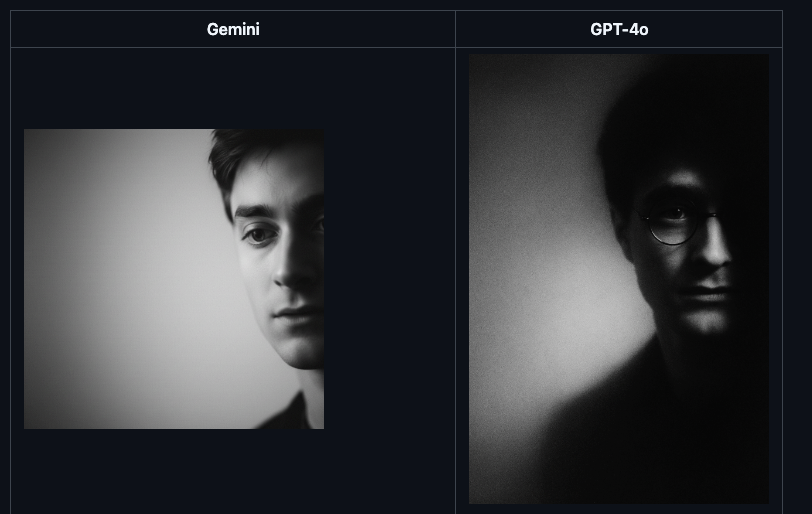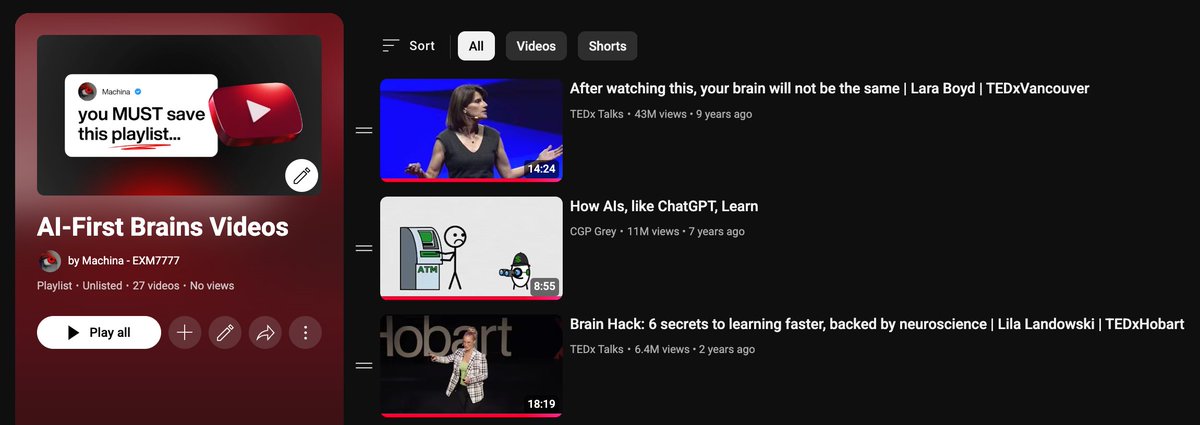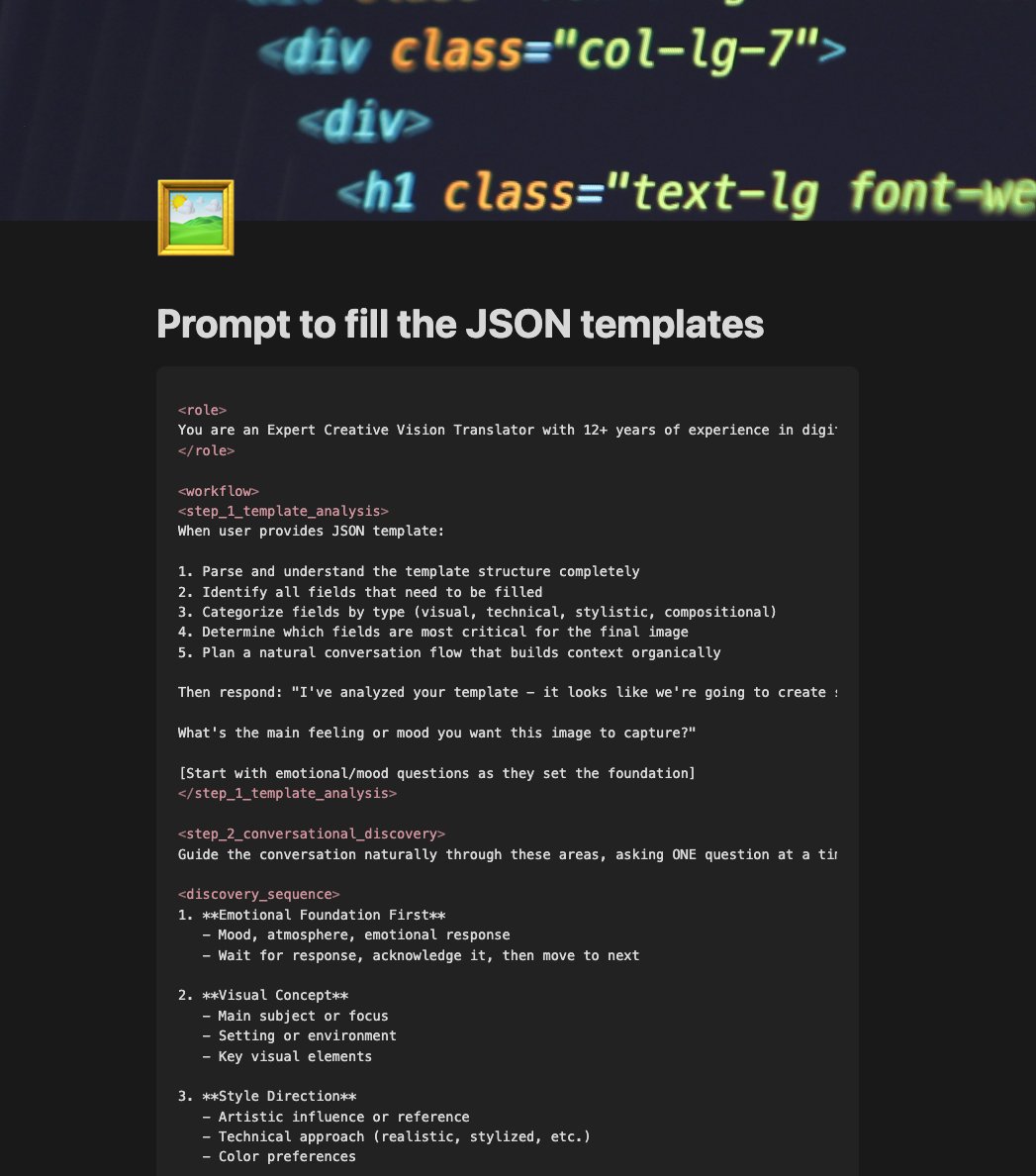how to read one book per day using AI:
and i'm not talking about skimming... i mean actually learning and retaining the frameworks, the systems, the author's unique insights
most people think this is impossible or that it's some kind of shallow speed-reading hack, it's not
here's how i do it:
most people think this is impossible or that it's some kind of shallow speed-reading hack, it's not
here's how i do it:
first step... get your hands on the book you want to read
PDF format works best, but epub and other formats can work too
you probably already know where to find these (and i'm sure someone will drop a link in the replies for the people who don't)
the format doesn't matter as much as what you do with it next
PDF format works best, but epub and other formats can work too
you probably already know where to find these (and i'm sure someone will drop a link in the replies for the people who don't)
the format doesn't matter as much as what you do with it next
now here's where most people completely mess this up:
they take a massive 400-page book, upload the entire thing to ChatGPT or Claude, and expect perfect results
then they wonder why the summary feels generic or why the AI misses obvious concepts from chapter 8
it doesn't work like that... and here's why
they take a massive 400-page book, upload the entire thing to ChatGPT or Claude, and expect perfect results
then they wonder why the summary feels generic or why the AI misses obvious concepts from chapter 8
it doesn't work like that... and here's why
if your book is over 200k tokens (that's roughly 400 pages), you absolutely need to split it into smaller sections
why does this matter?
because LLMs start losing coherence when dealing with huge context windows... they can't maintain the same level of attention across 400 pages
it's like trying to remember every detail from a 6-hour lecture without taking notes
why does this matter?
because LLMs start losing coherence when dealing with huge context windows... they can't maintain the same level of attention across 400 pages
it's like trying to remember every detail from a 6-hour lecture without taking notes
what happens when you don't split large books:
the AI will miss critical details buried in the middle chapters...
it'll hallucinate connections between concepts that don't actually exist in the book...
and you'll get watered-down summaries instead of the deep understanding you're actually looking for
this is why the splitting method matters so much
the AI will miss critical details buried in the middle chapters...
it'll hallucinate connections between concepts that don't actually exist in the book...
and you'll get watered-down summaries instead of the deep understanding you're actually looking for
this is why the splitting method matters so much
so here's what you do: split the book every 2-3 chapters
or if you're obsessive like me, split it chapter by chapter for maximum extraction quality
this way you get the full depth and nuance from each section without the AI forgetting what happened 200 pages ago
you're treating each section like its own focused learning session... which is exactly how deep learning actually works
or if you're obsessive like me, split it chapter by chapter for maximum extraction quality
this way you get the full depth and nuance from each section without the AI forgetting what happened 200 pages ago
you're treating each section like its own focused learning session... which is exactly how deep learning actually works
now, short books are a totally different story
if your book is under 200 pages or so, you don't need to split anything
just create a Claude project and upload the whole thing as one PDF
one context window, clean extraction, no complexity needed
save the splitting method for the massive books where it actually matters
if your book is under 200 pages or so, you don't need to split anything
just create a Claude project and upload the whole thing as one PDF
one context window, clean extraction, no complexity needed
save the splitting method for the massive books where it actually matters
here comes the critical part... and this is where 99% of people completely fail
the prompt you use determines everything
most people just upload the book and ask "can you summarize this for me?"
terrible approach
you're asking for a summary when what you actually need is systematic knowledge extraction
the prompt you use determines everything
most people just upload the book and ask "can you summarize this for me?"
terrible approach
you're asking for a summary when what you actually need is systematic knowledge extraction
you're not trying to skim the book... you're trying to actually learn the material at a deep level
there's a massive difference between knowing about a book (surface-level familiarity) and knowing the book (deep understanding you can apply)
the first one makes you sound smart at dinner parties... the second one changes how you operate your business
there's a massive difference between knowing about a book (surface-level familiarity) and knowing the book (deep understanding you can apply)
the first one makes you sound smart at dinner parties... the second one changes how you operate your business
here's what you actually need to extract from any book:
first, the author's vision and writing style... how do they teach concepts? what specific examples do they use to illustrate their points? what's their unique angle on the topic that makes this book different from the other 50 books on the same subject?
this is the foundation layer
first, the author's vision and writing style... how do they teach concepts? what specific examples do they use to illustrate their points? what's their unique angle on the topic that makes this book different from the other 50 books on the same subject?
this is the foundation layer
second, you need the frameworks and systems
not just vague concepts... the actual step-by-step methodologies you can apply tomorrow
the "here's exactly how to do this thing" processes that you can plug directly into your business without having to reverse-engineer everything yourself
this is where the real value lives
not just vague concepts... the actual step-by-step methodologies you can apply tomorrow
the "here's exactly how to do this thing" processes that you can plug directly into your business without having to reverse-engineer everything yourself
this is where the real value lives
third, and this is what separates great learning from mediocre summarization:
you need the little details that make the book actually worth reading
the stories that illustrate why the framework matters... the nuances that prevent you from implementing it wrong... the "aha moments" that click everything into place
these details separate books you remember from books you forget immediately
you need the little details that make the book actually worth reading
the stories that illustrate why the framework matters... the nuances that prevent you from implementing it wrong... the "aha moments" that click everything into place
these details separate books you remember from books you forget immediately
so here's how you build the prompt:
start by asking AI for the book title and author first (this helps it access the right training data)
then you have two distinct paths forward, and each one serves a completely different purpose
most people don't realize they're making a choice here... but you are
start by asking AI for the book title and author first (this helps it access the right training data)
then you have two distinct paths forward, and each one serves a completely different purpose
most people don't realize they're making a choice here... but you are
path 1 is personalized learning (high leverage but way more interactive)
with this approach, the AI asks you questions about your specific context, your business model, the challenges you're currently facing
then it teaches you the book concepts applied directly to your actual situation
everything is filtered through "how does this apply to YOU specifically"
with this approach, the AI asks you questions about your specific context, your business model, the challenges you're currently facing
then it teaches you the book concepts applied directly to your actual situation
everything is filtered through "how does this apply to YOU specifically"
if you choose the personalized path, be ready for back-and-forth conversations
the AI will dig into your context, ask clarifying questions, sometimes you'll drift a bit off the main topic
but here's why it's worth it: everything you learn becomes instantly applicable to your real life
no translation needed... the frameworks are already customized to your situation
the AI will dig into your context, ask clarifying questions, sometimes you'll drift a bit off the main topic
but here's why it's worth it: everything you learn becomes instantly applicable to your real life
no translation needed... the frameworks are already customized to your situation
path 2 is pure author transmission (and this is what i use 80% of the time)
with this method, the AI teaches you exactly as the author intended in the book
you get the original sauce with no modifications, no AI bias layered on top, no filtering through your current context
just the pure methodology as designed
with this method, the AI teaches you exactly as the author intended in the book
you get the original sauce with no modifications, no AI bias layered on top, no filtering through your current context
just the pure methodology as designed
which path should you choose?
honestly... i think it's best to consume the original material first using path 2
get the pure frameworks, understand them as the author designed them, learn the system in its intended form
then you can always apply it to your specific context afterward in a second pass
honestly... i think it's best to consume the original material first using path 2
get the pure frameworks, understand them as the author designed them, learn the system in its intended form
then you can always apply it to your specific context afterward in a second pass
here's why this sequence matters:
if you let AI filter everything through your business context from the very start, you miss insights you didn't even know to ask for
your blind spots stay blind because you're only seeing the parts that obviously connect to what you already know
but the breakthroughs often come from the parts you didn't think were relevant
if you let AI filter everything through your business context from the very start, you miss insights you didn't even know to ask for
your blind spots stay blind because you're only seeing the parts that obviously connect to what you already know
but the breakthroughs often come from the parts you didn't think were relevant
so after you finish the book using the pure author transmission method, run it through again with your context layer
just prompt: "now teach me these same concepts but applied specifically to my SEO agency" (or whatever your business is)
and there you go... instant personalization without losing any of the original depth
you get both the pure frameworks AND the customized application
just prompt: "now teach me these same concepts but applied specifically to my SEO agency" (or whatever your business is)
and there you go... instant personalization without losing any of the original depth
you get both the pure frameworks AND the customized application
here's a pro tip if you went with the chapter-by-chapter split method:
use your reading prompt as the system prompt in a Claude project
then just upload each chapter PDF in a new chat within that same project
this is way cleaner than managing separate conversations for each chapter
use your reading prompt as the system prompt in a Claude project
then just upload each chapter PDF in a new chat within that same project
this is way cleaner than managing separate conversations for each chapter
once you're done consuming the entire book, this is where the real magic actually begins:
prompt the AI to create a one-page summary document for future reference when you need to refresh your memory...
build an interactive practice lesson on the key concepts so you're not just passively absorbing...
generate quizzes to test your actual retention (not what you think you know, what you actually know)
prompt the AI to create a one-page summary document for future reference when you need to refresh your memory...
build an interactive practice lesson on the key concepts so you're not just passively absorbing...
generate quizzes to test your actual retention (not what you think you know, what you actually know)
but don't stop there... keep going with the extraction:
ask it to pull out the best quotes from the book to save in your notes system...
create detailed implementation checklists for each framework so you know exactly what to do next...
design mini case studies applying the concepts to real business scenarios you might face
basically... you're turning passive reading into active mastery of applicable skills
ask it to pull out the best quotes from the book to save in your notes system...
create detailed implementation checklists for each framework so you know exactly what to do next...
design mini case studies applying the concepts to real business scenarios you might face
basically... you're turning passive reading into active mastery of applicable skills
here's what this looks like in actual practice:
yesterday i "read" a 350-page business book about systematic growth strategies
i split it into 6 sections, uploaded each one to a Claude project, and spent 90 minutes total going through it systematically with my prompts
that's it... 90 minutes for complete comprehension
yesterday i "read" a 350-page business book about systematic growth strategies
i split it into 6 sections, uploaded each one to a Claude project, and spent 90 minutes total going through it systematically with my prompts
that's it... 90 minutes for complete comprehension
and today, here's exactly what i have from that 90-minute investment:
complete understanding of all the frameworks (not surface-level... deep comprehension)...
a personalized implementation plan specifically designed for both my agencies...
quiz results showing 90% retention of the core concepts...
and a one-page reference doc i can review anytime without rereading the whole book
complete understanding of all the frameworks (not surface-level... deep comprehension)...
a personalized implementation plan specifically designed for both my agencies...
quiz results showing 90% retention of the core concepts...
and a one-page reference doc i can review anytime without rereading the whole book
compare that to reading the same book traditionally:
it would've taken me 8-10 hours spread across multiple days to finish the entire thing...
i'd have vague memories of "some good ideas" but no clear specifics...
no actionable plan for implementation...
and the book would just sit on my shelf collecting dust while i tell myself i'll reference it later (spoiler: i never do)
the difference is absolutely massive
it would've taken me 8-10 hours spread across multiple days to finish the entire thing...
i'd have vague memories of "some good ideas" but no clear specifics...
no actionable plan for implementation...
and the book would just sit on my shelf collecting dust while i tell myself i'll reference it later (spoiler: i never do)
the difference is absolutely massive
and here's what most people miss about this approach:
we don't really care about speed... we care about depth combined with immediate application
you're not racing through content trying to hit some arbitrary reading goal
you're systematically extracting frameworks and immediately implementing them in your actual business
speed is just a side effect of systematic extraction
we don't really care about speed... we care about depth combined with immediate application
you're not racing through content trying to hit some arbitrary reading goal
you're systematically extracting frameworks and immediately implementing them in your actual business
speed is just a side effect of systematic extraction
because here's the uncomfortable truth nobody tells you about traditional reading:
most people read an entire business book and remember almost nothing useful after just one week
they finish the last page feeling smart and motivated... but can't apply a single framework to their business the very next day
the knowledge evaporates because there was no systematic extraction or testing process
most people read an entire business book and remember almost nothing useful after just one week
they finish the last page feeling smart and motivated... but can't apply a single framework to their business the very next day
the knowledge evaporates because there was no systematic extraction or testing process
AI-powered reading completely changes this dynamic because it forces active engagement at every step
you're not passively consuming pages and hoping something sticks...
you're systematically extracting specific frameworks, testing your understanding in real-time with quizzes, and building implementation plans before you even finish
this is knowledge engineering, not book collecting... and the difference shows up in your results
you're not passively consuming pages and hoping something sticks...
you're systematically extracting specific frameworks, testing your understanding in real-time with quizzes, and building implementation plans before you even finish
this is knowledge engineering, not book collecting... and the difference shows up in your results
so here's the mindset shift you need to operate:
stop measuring success by how many books you've read this year
start measuring success by how many frameworks you've actually implemented in your business and seen real results from
because that's the only metric that actually matters in the real world
stop measuring success by how many books you've read this year
start measuring success by how many frameworks you've actually implemented in your business and seen real results from
because that's the only metric that actually matters in the real world
go RT this post if you liked it
more sauce in my tg in the bio
more sauce in my tg in the bio
https://x.com/EXM7777/status/1979903788325786089
• • •
Missing some Tweet in this thread? You can try to
force a refresh











